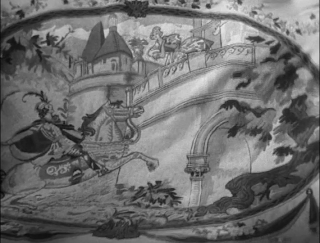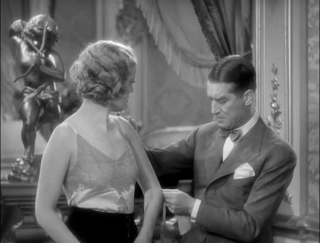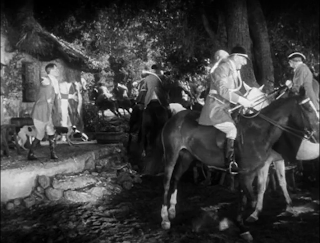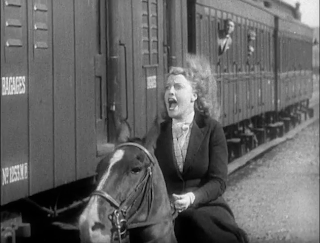
Love Me Tonight starts with the ringing of bells, then fades in to shots of Paris, rooftops, streets, the Seine. We see a lone bicyclist, hear the swish of his tires on the street, then see an overhead shot of one street, with a man pushing a wheelbarrow. We hear its wheels; he stops, tosses his tools into the street (clank, clank), and he starts working, pounding a steady rhythm. We cut to an overhead shot of a bum, asleep, snoring. Then to a woman sweeping; to steam whistling from a chimney; to windows opening, a baby crying, to a man with a sawhorse, kids in the street, another man opening a store; women hanging out clothes, flapping them off their balconies; two cobblers sit down to their work, pounding nails (bang: tap/tap - bang: tap/tap); a knife grinder grinds, there's traffic in the streets, there's a woman pounding a rug, a car horn sounds - all of it mixes together, layered on everything else, a symphony of sounds, finished, so to speak, by a woman opening her window and turning on her gramophone, the whole street come together in music. And the camera goes into one room and finds Maurice Chevalier, dressing for the day, trying to shut out the noise, but not able to resist it - give him a second, and he'll be singing along.

And after that? It's all like that - Love me Tonight is a fairy tale, about a tailor who goes to collect a debt from a profligate Vicomte, and meets a princess, locked in a tower, surrounded by (mostly well meaning) jailers - mostly old men, though Myrna Loy is along as a bit of a comic foil; do they fall in love? does he rescue her? does he rescue him? It's hardly a mystery, as the whole film is a vast celebration of music and love, of community and life, and the wonders of film. It's a light, joyous story, and the film - everything - music, dialogue, performances, filmmaking - is as exuberant as the story.
Rouben Mamoulian directs, and he pulls out the stops. It's a trove of cinematic devices - musical and theatrical as well, and all together. The opening sequence with its natural sounds incorporated into music; the "pass-along" songs, especially Isn't it Romantic?; the way dialogue slips into lyrics and back, conversations sung, or half sung, rhymed at any rate; strictly cinematic tricks, like fast motion, slow motion, split screens, 180 degree cutting, animation, double exposure; theatrical tricks like direct address to the audience, use of shadows and mirrors, visual jokes. It's all there, for the joy of it all - but also working, all the time, to pull everyone together - especially the lovers - but everyone. It's a film of choruses, mostly - the streets of Paris, the people Isn't it Romantic passes through, the reprise of Mimi, the ensemble performance of The Son of a Gun is Nothing but a Tailor. Plus a duet or two, and complimentary songs for the lovers when they meet.
Everything in the story brings the lovers together; everything in the filmmaking brings them together; the whole affair works to make sure they fall in love and all is well. Right off the bat - Maurice sings in Paris - Isn't it Romantic? - and the song makes its way across France to Jeannette MacDonald, locked in her tower.
The usual complications arise - he runs her off the road; he charms and annoys her with a song; at the Chateau, the Vicomte has to pass him off as a Baron to keep him around long enough to scare up the money, and Jeannette takes a dislike to him. Myrna Loy tries to take him for herself; Charles Butterworth's count (who imagines himself a suitor for Jeannette) suspects him - but there is no way around it. Everything is against them - or with them - whatever it is. Her maiden aunts weave spells for her:

Cupid - cupid isn't subtle about it:

And Maurice can charm wild animals and wild men - saving a stag, and then sending the hunt away in slow motion, in a scene worthy of Cocteau:

How else could it end?

Though that is not the end. Our lovers come together, kissing in the garden, pledging love - whoever you are, whatever you are, wherever you are - united in their dreams (in song; in bed) - but there is more. He is a tailor - she is a princess - how can they be wed? But that can't be the end either - so if the prince can't ride up and save the princess from her tower, she will ride out and save him.

And that? Might be that. So back to the chateau and the three aunts, sewing, and their tapestry - which just happens to exactly reverse (in gender and angle) the actual end of the film. (Mamoulian doesn't miss much.) But someone rescues someone and everyone is happy, and so are we. It is a marvelous ensemble - the fantastic, inventive filmmaking, the outstanding Rogers and Hart songs, the witty, sexy dialogue, and an inspired cast - it's a joy from start to finish.

No comments:
Post a Comment